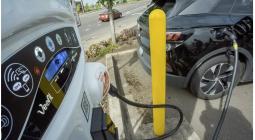Chicago Architects Aim to Turn ‘Super-Tall’ Buildings into Giant Batteries

The Chicago-based architecture firm that built the world’s tallest structure in Dubai is looking to design skyscrapers that use gravity storage to reduce climate pollution.
The prototype designs by Skidmore, Owings & Merrill LLP (SOM) “use electric motors to elevate massive blocks, creating potential energy that can be converted into electricity when the blocks are lowered,” Bloomberg Green reports. “The designs are based on technology developed by partner Energy Vault Holdings Inc. as an alternative to lithium-ion batteries and other types of chemical cells.”
Energy Vault has just completed its first major project in Shanghai, a 25-megawatt/four-hour storage system that uses a concept similar to pumped storage in hydropower plants. SOM sees the system as a way to tackle the emissions produced when a large building is built.
“For building owners looking to zero out emissions, turning a skyscraper into a massive battery is one avenue,” Bloomberg writes.
The very tall buildings that are SOM’s specialty increase the storage potential in the system, allowing more scope to raise the blocks when electricity is abundant and cheap, then release it when demand is high. “If I store it twice as high, twice the energy,” said SOM consulting partner Bill Baker. “High is better.”
In a building taller than 200 metres, “a gravity storage system could supply more than enough power to cover its operations,” Bloomberg explains. “That’s when building operators can start to offset the carbon footprint of construction materials, with some of SOM’s designs expected to see that payback in two to four years.”
Energy Vault’s current systems operate at a cost of 5 to 10¢ per kilowatt-hour, said CEO Robert Piconi, compared to about 13.5¢ for lithium-ion batteries, and the company’s goal is to get the cost down below 5¢. “Instead of buildings being carbon emitters, think about a carbon payback,” Piconi told Bloomberg.
But with negotiations under way with potential customers in the Middle East, Bloomberg says Energy Vault’s plans to begin construction on a new building in early 2026 may be over-optimistic. The company has faced development hurdles and has seen its share price fall 85% since it went public in 2022. While the concept behind the buildings is sound, said investment banking analyst Thomas Boyes, it can take years to get the projects through permitting and financing, and there’s only a limited market for battery projects in so-called “super-tall” buildings that exceed 300 metres in height.




